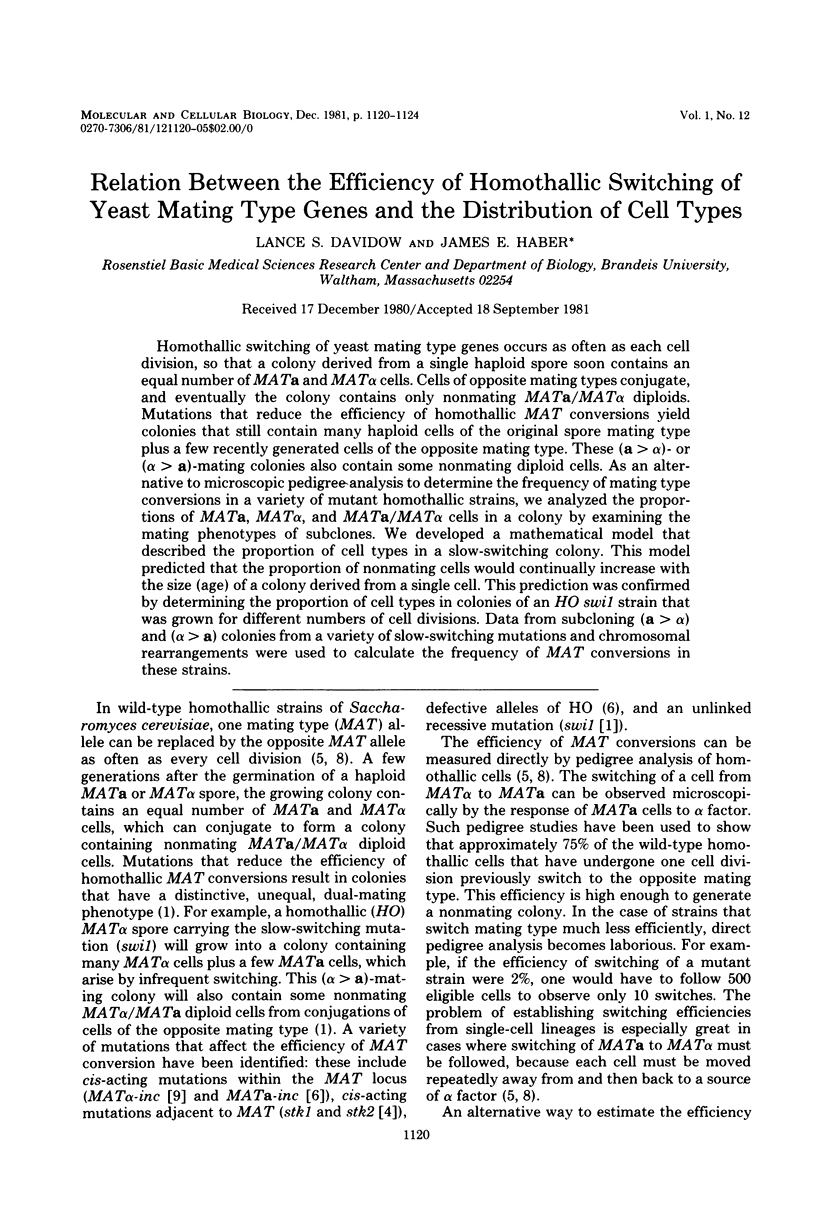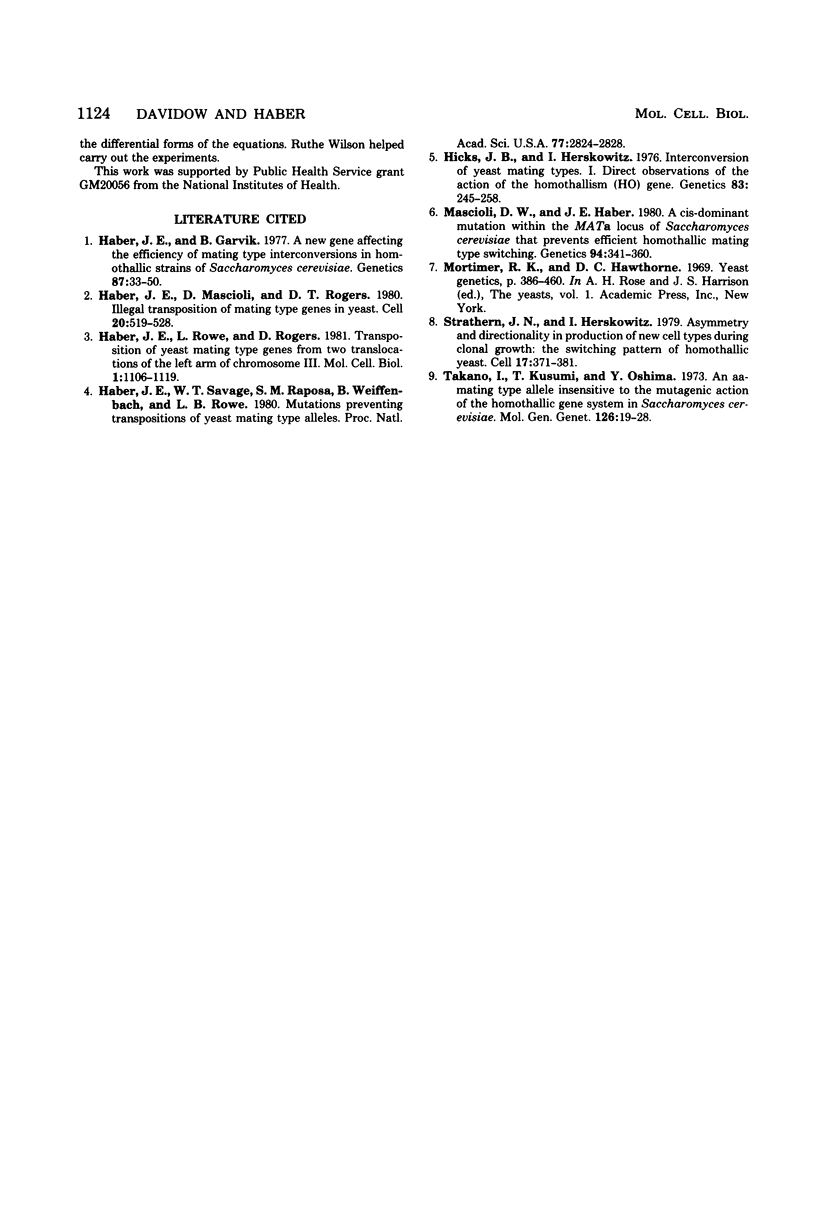Abstract
Homothallic switching of yeast mating type genes occurs as often as each cell division, so that a colony derived from a single haploid spore soon contains an equal number of MATa and MAT alpha cells. Cells of opposite mating types conjugate, and eventually the colony contains only nonmating MATa/MAT alpha diploids. Mutations that reduce the efficiency of homothallic MAT conversions yield colonies that still contain many haploid cells of the original spore mating type plus a few recently generated cells of the opposite mating type. These (a greater than alpha)- or (alpha greater than a)-mating colonies also contain some nonmating diploid cells. As an alternative to microscopic pedigree analysis to determine the frequency of mating type conversions in a variety of mutant homothallic strains, we analyzed the proportions of MATa, MAT alpha, and MATa/MAT alpha cells in a colony by examining the mating phenotypes of subclones. We developed a mathematical model that described the proportion of cell types in a slow-switching colony. This model predicted that the proportion of nonmating cells would continually increase with the size (age) of a colony derived from a single cell. This prediction was confirmed by determining the proportion of cell types in colonies of an HO swi1 strain that was grown for different numbers of cell divisions. Data from subcloning (a greater than alpha) and (alpha greater than a) colonies from a variety of slow-switching mutations and chromosomal rearrangements were used to calculate the frequency of MAT conversions in these strains.
Full text
PDF




Selected References
These references are in PubMed. This may not be the complete list of references from this article.
- Haber J. E., Garvik B. A new gene affecting the efficiency of mating-type interconversions in homothallic strains of Saccharomyces cerevisiae. Genetics. 1977 Sep;87(1):33–50. doi: 10.1093/genetics/87.1.33. [DOI] [PMC free article] [PubMed] [Google Scholar]
- Haber J. E., Mascioli D. W., Rogers D. T. Illegal transposition of mating-type genes in yeast. Cell. 1980 Jun;20(2):519–528. doi: 10.1016/0092-8674(80)90638-8. [DOI] [PubMed] [Google Scholar]
- Haber J. E., Rowe L., Rogers D. T. Transposition of yeast mating type genes from two translocations of the left arm of chromosome III. Mol Cell Biol. 1981 Dec;1(12):1106–1119. doi: 10.1128/mcb.1.12.1106. [DOI] [PMC free article] [PubMed] [Google Scholar]
- Haber J. E., Savage W. T., Raposa S. M., Weiffenbach B., Rowe L. B. Mutations preventing transpositions of yeast mating type alleles. Proc Natl Acad Sci U S A. 1980 May;77(5):2824–2828. doi: 10.1073/pnas.77.5.2824. [DOI] [PMC free article] [PubMed] [Google Scholar]
- Hicks J. B., Herskowitz I. Interconversion of Yeast Mating Types I. Direct Observations of the Action of the Homothallism (HO) Gene. Genetics. 1976 Jun;83(2):245–258. doi: 10.1093/genetics/83.2.245. [DOI] [PMC free article] [PubMed] [Google Scholar]
- Mascioli D. W., Haber J. E. A CIS-Acting Mutation within the MATa Locus of SACCHAROMYCES CEREVISIAE That Prevents Efficient Homothallic Mating-Type Switching. Genetics. 1980 Feb;94(2):341–360. doi: 10.1093/genetics/94.2.341. [DOI] [PMC free article] [PubMed] [Google Scholar]
- Strathern J. N., Herskowitz I. Asymmetry and directionality in production of new cell types during clonal growth: the switching pattern of homothallic yeast. Cell. 1979 Jun;17(2):371–381. doi: 10.1016/0092-8674(79)90163-6. [DOI] [PubMed] [Google Scholar]
- Takano I., Kusumi T., Oshima Y. An alpha mating-type allele insensitive to the mutagenic action of the homothallic gene system in Saccharomyces diastaticus. Mol Gen Genet. 1973 Oct 16;126(1):19–28. doi: 10.1007/BF00333478. [DOI] [PubMed] [Google Scholar]


